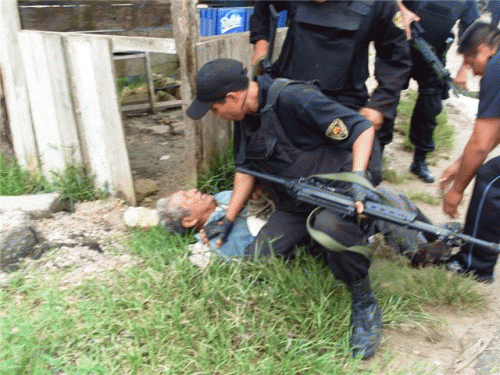
Five days ago, on October 3, 2008, federal and state police in Chiapas, Mexico, carried out a violent operation that left six people dead, 17 injured, and 36 more detained, almost all of whom were inhabitants of the ejido (communally held land) of Miguel Hidalgo, located in the municipality of La Trinitaria, Chiapas.
Leading up to the attack, on September 7th, members of the ejido attempted to reclaim a Mayan archeological site located near the city of Comitán, with the plan of taking over its administration. In response, the Instituto Nacional de Antropologia y Historía (INAH, National Institue of Anthropology and History), which had previously been administrating the site, filed a lawsuit against those involved in the reclamation. A series of negotiations followed, with the last one taking place on October 2.
The International Service for Peace (SIPAZ) explains what happened the following day:
On October 3rd, approximately at 11:00 AM, the first police operation began with the arrival of 40 members of the State Preventive Police (PEP) and the Judicial Police (Policia Ministerial), who entered the community in vehicles, horses, and on foot and began throwing tear gas and breaking into a number of houses. The members of the community blocked their entrance with rocks, shovels, and machetes, provoking the first confrontation. [community members also rushed a number of the officers, disarming them and locking them up.]
Around 5:30 PM, 300 agents of the Federal Preventative Police (PFP), the Judicial Police, the Federal Investigation Agency (AFI), and the State Preventive Police began to enter the community again, provoking another confrontation. According to testimonies, police agents used firearms which injured a number of people.
According to information made public by Fray Bartolome de Las Casas Human Rights Center, Agustin Alfaro Alfaro, who lives in a nearby town, together with his wife and one of his sons in his arms, came with his truck to help move the injured persons to a nearby hospital. On the road, they were intercepted by a truck of the State Preventative Police which began to shoot at them. After getting out of their truck, the police shot Mr. Alfaro in the chest and executed three more people on the spot (Rigoberto López, Alfredo Hernández, and Miguel Antonio Martínez). The wife of Mr. Alfaro, Eloisa Margarita Espinoza Morales, and her son escaped unharmed, they witnessed these events.
Two other people (Ingacio Hernández López and Ricardo Ramírez Ramírez), wounded by gunshots, died on the way to the Hospital of Amparo Agua Tinta, which is in the municipality of Las Margaritas.
The 36 detained campesinos, who were transferred to San Cristóbal de las Casas and to La Trinitaria, were liberated on October 5th in exchange for the guns that people of the community had taken from the police on the morning of October 3rd.
According to Fray Bartolome de Las Casas Human Rights Center, of the 17 campesinos who were wounded, 6 of which received gunshot wounds, 2 are still in critical condition. The authorities have stated that 22 were wounded: 16 police and 6 farmers.
A slight change from the constant injustice we so often find in Mexico, Chiapas state Governor Juan Sabines has since “promised to punish the police who were responsible for the violence, indemnify the victims’ families, provide scholarships to their children and pensions to their widows, and launch productive projects in the community,” reports IPS News.
According to SIPAZ, state and federal authorities have already paid 35.000 pesos (approximately 2800 USD) to cover funeral expenses and 75.000 pesos (approximately 6000 USD) to support the families of the victims.
Sabine also traveled to Miguel Hidalgo to apologise and offer his condolences to the families. “The government here is not fighting with the people; these incidents did not only happen to you, they happened to everyone in Chiapas,” said the governor.
Even though the government has taken an “apparently different stance this time,” Jorge Luis Hernández from the Fray Bartolomé de las Casas Human Rights Centre (FRAYBA) says “the pattern of criminalising social protests remains in place.”
In fact, on the same day of the October 3 attack, there was another police operation in Chiapas. SIPAZ points out that the police also mobilized against “the communities of Antelá, Nueva Rosita y Nuevo Hidalgo, where last September groups of indigenous people had blocked the Lagunas de Montebello National Park. Up until then, the park had been administered by the National Commission of Protected Areas (CONANP).”
The Human Rights Centre has documented several more incidents of “repression” against the people of Chiapas this year, which they blame on “state agents,” not merely the police.
Demanding that the governor fulfill his promises, the Centre says that at both the federal and state government must conduct an impartial and efficient investigation into the Miguel Hidalgo attack, and then punish everyone that was involved — even if it leads to Sabines’s associates in the government.
They further demand the government bring an end to its policy of criminalization, by “ensur[ing] the non repetition of the abuses and excessive use of force by law enforcement officials.”
More Photos and information can be found at FRAYBA (Spanish)

Indigenous Peoples are putting their bodies on the line and it's our responsibility to make sure you know why. That takes time, expertise and resources - and we're up against a constant tide of misinformation and distorted coverage. By supporting IC you're empowering the kind of journalism we need, at the moment we need it most.